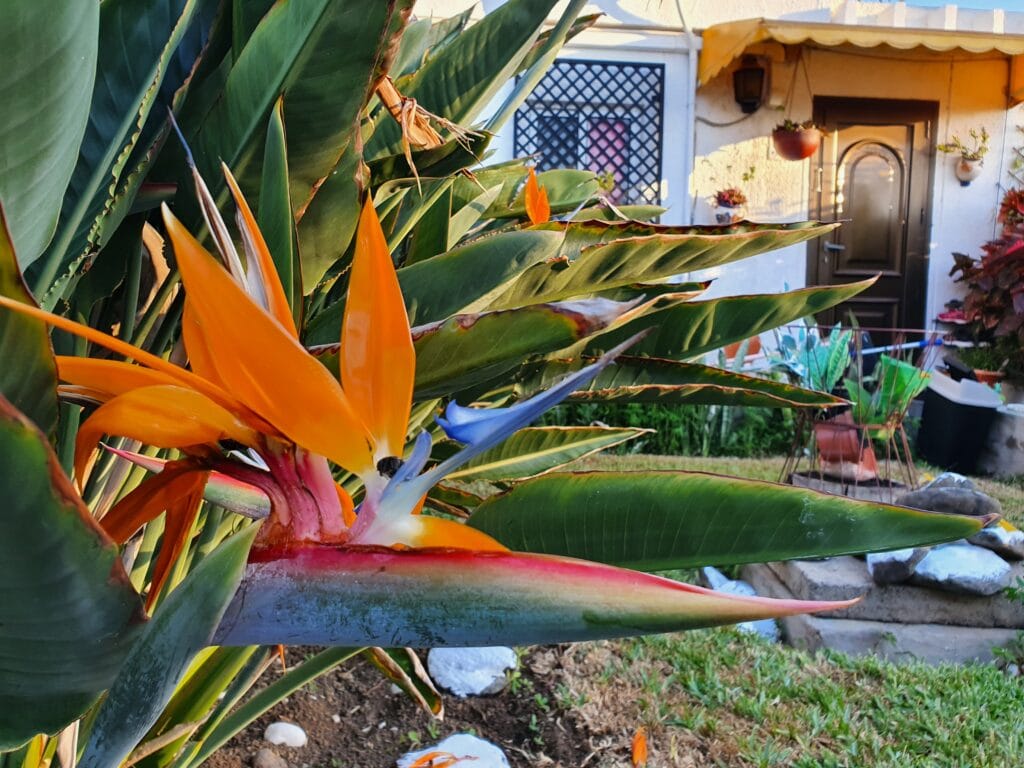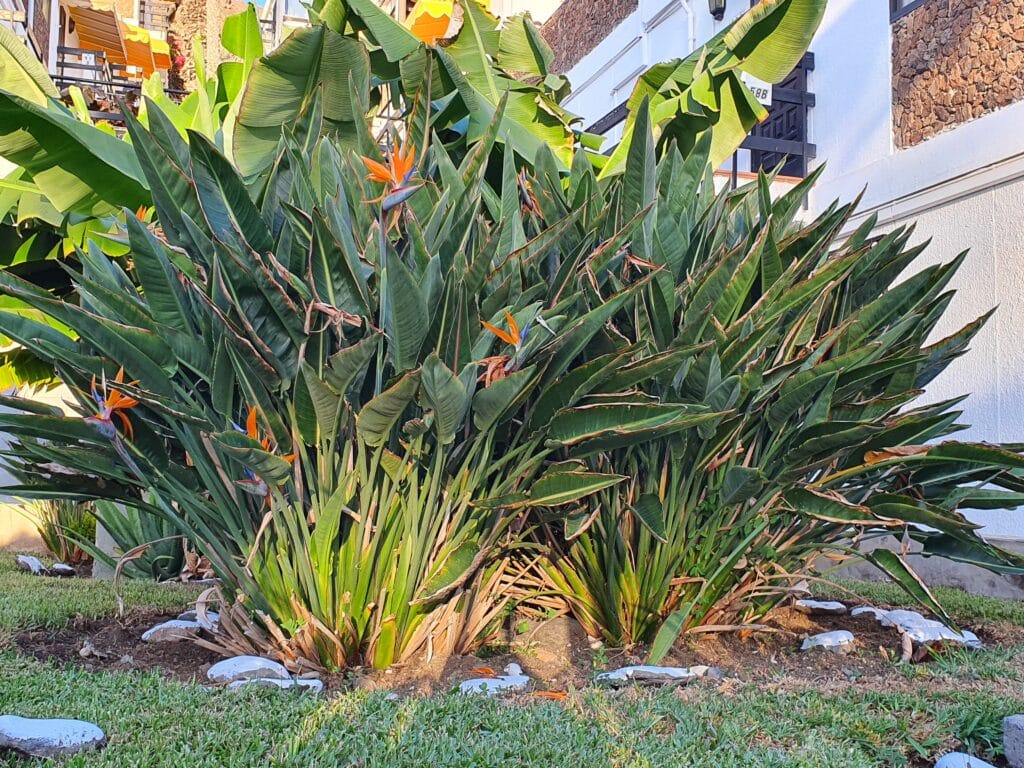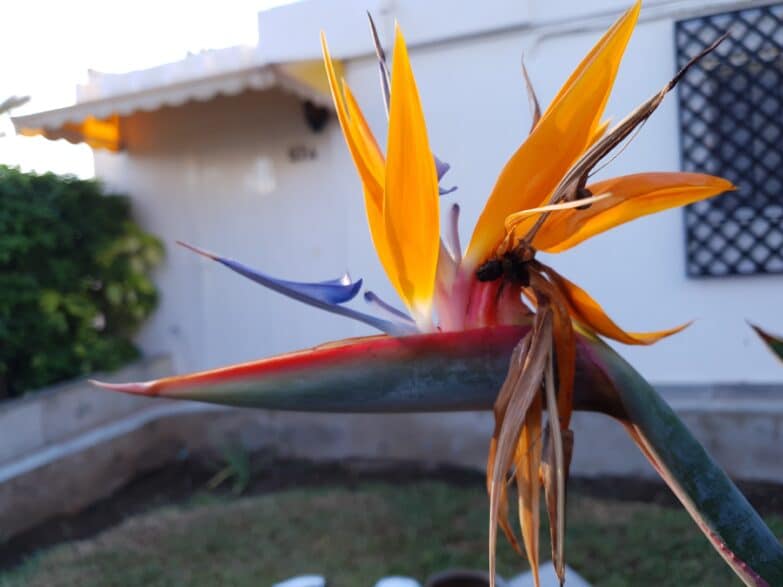The Bird of paradise plant also known as Crane flower and Strelitzia is a tropical plant native to the Canary Islands and Latin America, where it grows freely in natural habitats like bushy wildflowers. It belongs to the genus Strelitziaceae, which includes several species of plants whose common feature is an unusual, very unique, exotic, and extravagant crane-like flower. The genus was given the botanical name Strelitzia in honor of Queen Charlotte of Mecklenburg-Strelitz, the wife of King George III of England, a great lover of botany.Since the middle of the 18th century, when it was brought to Europe, its popularity does not decline, making it one of the most sought-after indoor plants and desirable garden decorations in areas where climatic conditions allow it.
Plant profile
Strelitzia is a perennial evergreen of dense, bushy growth that, depending on the species, can grow from 5 to an impressive 30 feet in height. Its shiny, leathery leaves with a grayish-green surface are oval-lanceolate in shape resembling banana leaves. They can grow from 12 to 30 inches in length, with broadleaf blades up to 4 to 20 inches wide.
The leaves appear on firm elongated stalks at least 15 inches long, growing vertically and directly from a robust, branched, rhizome root system. These sizable, striking foliage make the plant attractive even when not blooming, creating distinct structural effects and an irresistible tropical atmosphere both indoor or outdoor.
Bird of Paradise Flower
Even though the plant retains its tropical charm without blooms yet, what makes this plant popular worldwide are its uniquely shaped flowers.
These wondrous flowers appear on long stalks from a thickened horizontally placed beak-like lodge, resembling the intensely colored orange and blue-purple tufts on the head of a crane. Five or six flower capsules appear on each stalk, and each bush produces many new ones, which can extend the flowering season to six months.
Due to its durability, resilience, and longevity, the bird of paradise flower is one of the best-selling cut flowers in the world. It stays fresh in a vase with water for twenty days!
From the pollinated flowers, hard, black, spherical seeds decorated with funny orange tufts are formed. The seeds attract birds that spread them in the wild, helping the species propagate in the landscape.
Orange Birds of Paradise
The most often grown species of Bird of paradise is the so-called Strelitzia Reginae, the royal strelitzia as its Latin name suggests. It is popular because of the stunning, vibrant orange and purple flowers and the manageable size since it grows up to 5 feet indoors and 3 to 4 feet outdoors. Its leaves are more reminiscent of boat pedals growing densely next to each other on long stalks. Each leaf grows 7 inches long and 5 inches wide, forming a dense green crown.

White Birds of Paradise
Another popular species is Strelitzia Nicolai, also known as the White bird of paradise or Wild banana. It is a giant plant that can even grow in the shape of a tree in nature, reaching 15 feet high and spreading to 10 feet. Due to its size and the great need for light, the plant is more often grown outdoors or in greenhouses. It has banana-like, sizable leaves with short stalks, and the flower capsules are dark purple, which creates a dramatic contrast to the white bracts of the flowers.
How to Care for Birds of Paradise Plant
Despite its exotic appearance, Birds of paradise does not require any special or excessive care. As long as you provide it with enough space, adequate lighting, well-drained substrate, moderate watering, and a warm environment, this long-lived, slow-growing plant will create the tropical atmosphere in your living space for years! Hence, let us discuss its growth conditions one by one:
Birds of Paradise Light Requirements
If you grow the Bird of paradise plant indoors, place it in the brightest possible point in the space where it will get a lot of indirect lighting. Ideal positions are glazed verandas or heated loggias.
Yet, in the absence of such positions, you can place your Bird of paradise plant next to a large east or west window. A few hours of morning or afternoon sun has a beneficial effect, but you should avoid positions where the plant is exposed to direct sunlight at its zenith. The plant requires a minimum of 6 hours of light daily, in summer and winter.
The amount of light that the plant receives directly affects its growth, overall appearance but also flowering. Plants that spend time in an inadequately lit area will not bloom.
Therefore, you can add some artificial light to solve the issue. You could hang a lamp above or place it on a small table next to the plant. Keep it on for ten hours a day to make up for the lack of natural light.
Water Requirements
The watering regime of each plant always depends on the overall conditions in which it grows, primarily on exposure to light and room temperature. These factors directly affect the rate of moisture evaporation from the soil and dictate the watering frequency.
Generally, you could water the Bird of paradise plant once a week from spring to fall and once in ten days during the winter. However, this is just a framework since you need to adapt the watering to the specific plant and the conditions. Consequently, you should water your Bird of paradise as soon as you notice that the substrate surface layer is dry to a depth of 1 inch.
Adult plants are more tolerant of lack of water but do not leave them thirsty for too long.
On the other hand, excessive soaking of the substrate is even more dangerous. Water that the plant cannot use accumulates around the root system and causes its root and eventual decay.
From the end of autumn, gradually reduce watering, allowing the substrate to dry. Shortening the days in the winter months as well as lower temperatures slow down the plant’s metabolism. It is the period when the plant rests, and the water evaporates more slowly from the substrate, so there is no need to water it often.
And, just one thing more: The Bird of paradise plant does not like tap water! It contains salts and chloride to which the plant is not accustomed to Therefore, when you hydrate your plant use stagnant, soft water, distilled water or rainwater if you have the opportunity to collect it!
Soil Requirements
In terms of soil, the Bird of paradise plant is not picky as long as the substrate is well-drained and does not retain water longer than it should. In other words, you can grow it in a standard all-purpose substrate intended for indoor plants to which you could add a handful of compost or loam.
This supplement prevents soil compaction, increases its nutritional value, and affects the pH merit of the soil. Namely, although it can grow in ph-neutral soils, the Bird of paradise plant prefers a slightly acidic one with an ideal range of pH 5.5 to 7.5.

Humidity
Like all other plants of similar origin, the Bird of paradise plant likes elevated humidity levels in its environment. Although it is pretty adaptable and tolerates even a standard humidity level of 30 to 40 percent, it will still feel better and grow better if that level is higher than average and reaches at least 60%.
Raising humidity levels might sound like a challenging and demanding process, but the truth is that it is easy to achieve. You can choose from a few simple methods listed below:
- Misting – Frequently spray the plant’s leaves with lukewarm stagnant water at room temperature. This measure can be significant for the plant’s health, especially in the winter months when due to space heating, there is excessive drying of the air, as well as in the summer during dry and hot days.
- The Pebble tray – It is another easy way to change the microclimatic conditions in the plant environment. Place the pot with the plant on a tray in which you put balls of expanded clay or coarse gravel and fill it with water. Gradually evaporating the water in the pot will help make the Bird of paradise plant feel at home.
- Humidifier – This simple device is a practical solution for those with many tropical plants or plants that require conditions similar to tropical ones. Set it to the desired value, and you can forget about the humidity issue!
Fertilizer
As we have already mentioned, the Bird of paradise plant has a large, branched root that quickly consumes nutrients from the substrate. Hence, additional feeding is one of the vital measures in preserving its health and abundant flowering. For this purpose, you can use a liquid, standard fertilizer for houseplants diluted to half the recommended dose. Add fertilizer dissolved in water to moist soil (immediately after watering) every fifteen days from spring to autumn when the plant grows and blooms intensively.
If you are a supporter of natural fertilizers, then you can feed the plant with steer manure. In the spring, before the season starts, bury one handful of this material in the soil around the plant, taking care not to damage the root and that the manure does not come into direct contact with the root ball.
After application, you could water the plant, and it should be enough to provide nutrition for the whole season.
Temperature
The Bird of paradise plant is sensitive to low temperatures and cannot thrive in a room where the temperature drops below 50 F. The ideal temperature range is between 60 and 75 F throughout the year. Therefore, keep the Bird of Paradise in a warm space that is heated during the winter.
In USA climate Zone 10 to 12 with a mild winter, the Bird of paradise plant can grow as an ornamental outdoor garden plant. Even in these areas, it is advisable to mulch the root with a layer of dry leaves to protect it from hypothermia in the case of sudden temperature drops, lower than the winter standard for this area (below 41 F).
In all other regions, the Bird of paradise plant is grown as a potted indoor plant. You can move it out in the garden or terrace, during the summer. However, when the night temperatures get close to 50 F, you should bring the plant into the house in a protected and warm space.
Potting and Repotting
Although not a fast-growing species, the Bird of paradise plant is a large plant that you can successfully grow only in a large pot, in which the root will have enough space. Therefore, you will need a stable container with a volume of at least 2 gallons (8 liters).
The container must have bottom openings to prevent dangerous accumulation of water in the pot. When planting your Bird of paradise plant, be sure to put a layer of coarse gravel or broken tiles on the bottom over the openings of the pot, which will have a drainage function and enable efficient draining of excess water.
This robust plant does not like constant transplanting, and it grows better and blooms profusely if the roots are partially compacted in a container. Thus, transplant it every second or third year when the roots appear through the drainage holes into one to two inches larger pot previously filled with fresh substrate.
Growth and Propagation
To bloom for the first time, the Bird of paradise plant must reach a stage of maturity that occurs in four to six years under optimal growing conditions. If that sounds too long to you, let’s say that a bird of paradise blossomed in the room is really a scene worth waiting for. Moreover, once it starts blooming, it gives more and more flowers every year.
Also, a mature plant produces seeds from which new plants can be propagated. For you who want to know more, here is the article about Birds of Paradise propagation.
Problems
In general, the Bird of paradise plant is a tough and durable plant that adapts to household conditions and is not particularly prone to diseases or pests. Most of the problems that can occur are related to inadequate surroundings or unfavorable growing factors. Here we single out the most common ones:
Brown spots or patches on the leaves appear when you use tap water or when the substrate is too wet and there is insufficient airflow between the leaves. Use soft water, ventilate the area, and water the plant only when the substrate is dry to touch.
- Dry leaf tips suggest a low amount of moisture in the space. Mist the plant regularly and clean its leaves with a damp cloth or sponge. The plant will enjoy this refreshing treatment because removing dust and particles accumulated on its leaves helps it breathe easier.
- Yellow, flabby, mushy leaves are a clear sign of excess water in the soil. Cut off such leaves and pay attention to the watering schedule. If you do nothing or leave the plant to sit in the wet substrate, the next stage is root rot which usually leads to loss of the plant. Consequently, remove the plant from the soggy substrate, dry it briefly in the air and replant it in a fresh substrate. Do not water for the first seven days!
- Slow growth or lack of flowers is usually the result of insufficient lighting or poor soil in which there are not enough nutrients. Light and fertilization play a vital role in the formation of flowers and the growth dynamics of this plant. So, provide it with regular nutrition and adequate lighting.
- Curling the leaves can be caused by various pests but also other factors of cultivation. To learn more about the problem and how to deal with it, you can find more information
Final thought
Once you see the enchanting flower of the Bird of paradise plant, it is impossible to mix it with any other flower in the world. Its origami form, so unique in the kingdom of flowering plants, and lush greenery of large leaves are more than enough reasons to try to grow this plant..Are you ready for the challenge and try, following our tips, to decorate your home with this exceptional plant?

